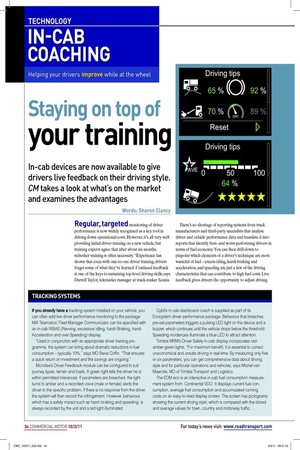Staying on top of
Page 29

Page 30

If you've noticed an error in this article please click here to report it so we can fix it.
your training
In-cab devices are now available to give drivers live feedback on their driving style. CM takes a look at what’s on the market and examines the advantages
Words: Sharon Clancy Regular, targeted monitoring of driver performance is now widely recognised as a key tool in driving down operational costs. However, it’s all very well providing initial driver training on a new vehicle, but training experts agree that after about six months, refresher training is often necessary. “Experience has shown that even with one-to-one driver training, drivers forget some of what they’ve learned. Continual feedback is one of the keys to sustaining top-level driving skills, says Darrell Taylor, telematics manager at truck-maker Scania. There’s no shortage of reporting systems from truck manufacturers and third-party specialists that analyse driver and vehicle performance data and translate it into reports that identify bestand worst-performing drivers in terms of fuel economy. You can then drill-down to pinpoint which elements of a driver’s technique are most wasteful of fuel – excess idling, harsh braking and acceleration, and speeding are just a few of the driving characteristics that can contribute to high fuel costs. Live feedback gives drivers the opportunity to adjust driving habits before they have too big an impact on fuel costs, points out Alan Gunner, product manager for telematics company Isotrak.
On-board sensors that control vehicle systems such as braking and fuel injection also capture performance data. Harsh acceleration data, for example, is derived directly from sensors on the throttle, braking data is provided by the electronic braking system and fuel consumption data from the engine management computer.
Third-party telematics software has traditionally downloaded the relevant data via the FMS port, but two companies (Isotrak and Masternaut) can now capture the data via non-intrusive clip-on interrogators that can easily be transferred from vehicle to vehicle. ■














































